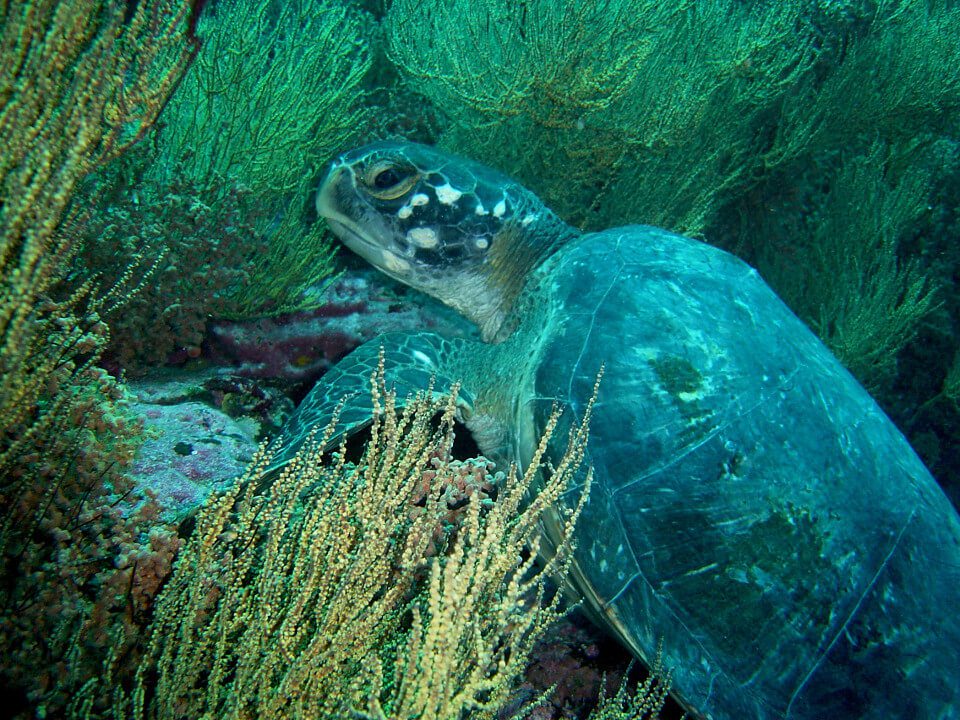Sea turtle mating season in Galapagos is quite a phenomenon to observe in the enchanted isles. It’s during this time of the year in particular that sea turtles begin looking for their respective mate in order to perpetuate this unique and mesmerizing species. Read along in this blog to find out how sea turtle mating season in Galapagos goes down.
TALK TO A DESTINATION EXPERT

Diego Zapata

Rosa Mena

Sandy Lara

Diego Zapata

Rosa Mena

Sandy Lara
Sea Turtle Mating Season in Galapagos: Time & Temperature
The specific species of sea turtle that lives in Galapagos is known as the green sea turtle (Chelonia mydas), and is the only known species of sea turtle that is known to nest there. This particular species tends to mature by the time their carapace is around 69 to 79 cm (27-31 in) in size, which is typically reached sometime between their 20 to 50 years of age (on average they live to be about 80 years old).
Sea turtle mating season in Galapagos tends to begin a few weeks prior to the nesting and hatching season in Galapagos, the former of which coincides with the influx of warmer temperatures both on land and in water. Day length (also known as photoperiod) increases during the hot season as well. It is believed that these serve as cues for sea turtles to begin copulating due to the fact that the sex of their eggs is highly contingent on the external temperatures.,. the optimal temperatures for beginning their nesting season is when incubation temperatures are roughly 29° C (84 °F).
As a result of these cues, sea turtles mating season in Galapagos often sees these unique creatures heading back to the beaches where they originally hatched – females because they know it’s an ideal nesting location, males because they’re acutely aware that they’ll find females here.
Sea Turtle Mating Season in Galapagos: A Tenacious Tale

Up until sea turtle mating season in Galapagos, sea turtles tend to be rather solitary, largely independent creatures. It’s only during this time of year that males approach females and begin their brief courtship gambit, which entails a nuzzle on the female’s head or soft bites along the back of her neck and rear flippers. Should the female stick around, the male then mounts and attaches himself to the female’s rear shell and secures himself by gripping the sides with his large claws (that only males have) on the front of his flippers.
Once attached, the male folds his tail/cloaca from which his long penis (sometimes up to half the length of his shell) extends itself to then inseminate the female’s cloaca.
From here on out, the female hangs on hard for sometimes up to 24 hours. Staying attached means the male can prevent other males from trying to mate with her. These other males will often try to violently bite at the tail and flippers of the attached male to “torture” him into letting go.
This creates and maintains a wide variety of genetic diversity in the population of sea turtles throughout the Galapagos, given that the eggs, in the end, are actually the net result of various fathers that have inseminated the female successfully. Serving as a crude reminder of these intense sea turtle mating season in Galapagos is the visual fact that females end up with scars across their shells.
Our guests in the Galapagos can experience sea turtles throughout the archipelago while aboard the Santa Cruz II Galapagos cruise! One of the biggest and most frequent spots for these magnificent creatures is along with Isabela and Fernandina Islands on our Western Islands Galapagos itinerary.

Javier Garcia

Eduardo Silva

Carolina Escobar
START PLANNING YOUR TRIP

Javier Garcia

Eduardo Silva

Carolina Escobar
Get in touch for more
CONTACT US


